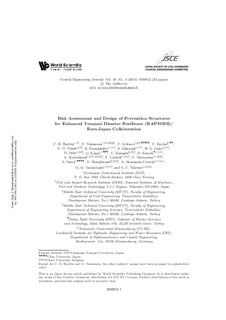Risk assessment and design of prevention structures for enhanced tsunami disaster resilience (RAPSODI) - Euro-Japan collaboration
Harbitz, Carl Bonnevie; Nakamura, Y.; Arikawa, T.; Baykal, C.; Dogan, G.G.; Frauenfelder, Regula; Glimsdal, Sylfest; Guler, H.G.; Issler, Dieter; Kaiser, Gunilla; Kânoǧlu, U.; Kisacik, D.; Kortenhaus, A.; Løvholt, Finn; Maruyama, Y.; Sassa, S.; Sharghivand, N.; Strusinska-Correia, A.; Tarakcloglu, G.O.; Yalciner, A.C.
Journal article
Permanent lenke
http://hdl.handle.net/11250/2426099Utgivelsesdato
2016Metadata
Vis full innførselSamlinger
- NGI articles [1061]
Sammendrag
The 2011 Tōhoku event showed the massive destruction potential of tsunamis. The Euro-Japan “Risk assessment and design of prevention structures for enhanced tsunami disaster resilience (RAPSODI)” project aimed at using data from the event to evaluate tsunami mitigation strategies and to validate a framework for a quantitative tsunami mortality risk analysis. Coastal structures and mitigation strategies against tsunamis in Europe and Japan are compared. Failure mechanisms of coastal protection structures exposed to tsunamis are discussed based on field data. Knowledge gaps on failure modes of different structures under different tsunami loading conditions are identified. Results of the wave-flume laboratory experiments on rubble mound breakwaters are used to assess their resilience against tsunami impact. For the risk analysis, high-resolution digital elevation data are applied for the inundation modeling. The hazard is represented by the maximum flow depth, the exposure is described by the location of the population, and the mortality is a function of flow depth and building vulnerability. A thorough search for appropriate data on the 2011 Tōhoku tsunami was performed. The results of the 2011 Tōhoku tsunami mortality hindcast for the city of Ishinomaki substantiate that the tsunami mortality risk model can help to identify high-mortality risk areas and the main risk drivers.
